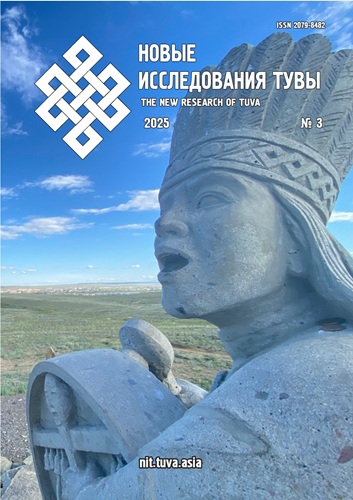Adaptive Strategies of Youth in the Republic of Tuva in Response to Labor Market Transformations
DOI:
https://doi.org/10.25178/nit.2025.3.17Keywords:
labor market; Republic of Tuva; sociocultural factor; youth; social transformation; economic adaptationAbstract
This article examines the nature, pace, and types of youth adaptation in the Republic of Tuva to labor market changes during the period from 2010 to 2023. The empirical basis for the analysis comprises data from a series of sociological surveys conducted by the authors among the population of the Republic of Tuva over the period.
The study explores youth responses to labor market transformations, which include: the stabilization and gradual reduction of the unemployment rate due to the emergence of new industries; sectoral shifts in the economy; industrial modernization and the transition to high-tech production; as well as the growing prevalence of flexible forms of employment such as remote work, freelancing, part-time jobs, and informal labor relations.
The article analyzes problems of adaptive behavior among population groups by assessing their attitudes toward traditional forms of employment, changes in occupational activity, job satisfaction, and patterns of labor mobility. The authors identify several psychological types of youth based on their degree of adaptation: active market participants, passive market participants, those adopting a wait-and-see approach, and involuntary market actors. The combined share of passive and wait-and-see segments accounts for 57–60%.
Findings suggest that the process of youth adaptation to the labor market remains insufficiently dynamic. Despite a slight increase in labor market participation, it still falls short of the requirements posed by ongoing socioeconomic changes. Passive forms of adaptation continue to dominate, casting doubt on the effectiveness of current adaptive practices and perpetuating the region’s lag in living standards relative to national averages. At the same time, youth exhibit relatively higher openness to adopting new adaptive strategies and show stronger willingness to adjust their labor behavior in alignment with evolving socioeconomic demands.
References
Abramova, M. A., Goncharova, G. S. and Kostyuk, V. G. (2014) Sociocultural Types of Youth: Ethnic and Regional Aspects. Novosibirsk, Avtograf. 179 p. (In Russ.)
Anaiban, Z. V. (2000) Youth of Tuva and Unemployment Issues. In: Popkov, Yu. V. (ed.) Ethnosocial Processes in Siberia, vol. 3. Novosibirsk, SB RAS Publishing. 267 p. Pp. 74–78. (In Russ.)
Anaiban, Z. V. (2017) Youth of Tuva and Khakassia in the 21st Century: Ethnosociological Essays. Moscow, Institute of Ethnology and Anthropology RAS. 240 p. (In Russ.)
Arutyunyan, Yu. V. (2007) Self-Identification of Urban Residents. In: Martynova, M. Yu., Lebedeva, N. M. (eds.) Youth of Moscow: Adaptation to Multiculturalism. Moscow, RUDN University. 527 p. Pp. 434–449. (In Russ.)
Balakina, G. F. (2016) Ethnosocial Features of Population Adaptation to the Market Economy in the Republic of Tuva. Region: Ekonomika i sotsiologiya, no. 4(92), pp. 176–195. (In Russ.)
Balakina, G. F. (2023) Specifics of Adaptive Practices Among Ethnic Groups of the Republic of Tuva. New Research of Tuva, no. 4, pp. 255–273. (In Russ.) DOI: https://doi.org/10.25178/nit.2023.4.18
Balakina, G. F. (2025) Research of Sociocultural Processes in the Republic of Tuva (1980s — Present). New Research of Tuva, no. 1, pp. 78–90. (In Russ.) DOI: https://doi.org/10.25178/nit.2025.1.6
Balakina, G. F. and Kylgyday, A. Ch. (2015) Ethnoregional Models of Adaptation to the Labor Market in Tuva. Ed. by L. V. Korel. Kyzyl, TuvIKOPR SB RAS. 160 p. (In Russ.)
Belyaev, V. I. and Kuznetsova, O. V. (2020a) Informal Employment as a Source of Precarity Formation in Russia: Research Methodology and Potential Assessment. Vestnik Tomskogo gosudarstvennogo universiteta. Ekonomika, no. 52, pp. 308–324. (In Russ.) DOI: https://doi.org/10.17223/19988648/52/19
Belyaev, V. I. and Kuznetsova, O. V. (2020b) The Precarious Segment of Social Structure in the Context of Labor Relations. Ekonomika. Professiya. Biznes, no. 2, pp. 5–13. (In Russ.) DOI: https://doi.org/10.14258/epb201966
Gaifullin, A. Yu. (2022) Ethnodemographic Characteristics of Youth in the Republics of Tuva and Bashkortostan. New Research of Tuva, no. 2, pp. 128–142. (In Russ.) DOI: https://doi.org/10.25178/nit.2022.2.9
Gasparishvili, A. T. (2016) Vocational Education in the Assessments and Opinions of Graduates of Secondary Vocational Institutions. Vestnik RUDN. Seriya: Sotsiologiya, no. 1, pp. 92–110. (In Russ.)
Gimpelson, V. E. and Kapelyushnikov, R. I. (2013) Is It Normal to Be Informal? Ekonomicheskiy zhurnal Vysshey shkoly ekonomiki, no. 1, pp. 3–15. (In Russ.)
Zubok, Yu. A. and Chuprov, V. I. (2020) Life Strategies of Youth: Expectation Fulfillment and Social Sentiments. Monitoring obshchestvennogo mneniya: Ekonomicheskiye i sotsial'nyye peremeny, no. 3, pp. 13–41. (In Russ.) DOI: https://doi.org/10.14515/monitoring.2020.3.1602
Zubok, Yu. A., Chuprov, V. I., Lyubutov, A. S. and Sorokin, O. V. (2021) Life Positions of Young People: Semantic Foundations of Formation. Vestnik Instituta sotsiologii, vol. 12, no. 3, pp. 79–98. (In Russ.)
Kapelyushnikov, R. I. (2022) Anatomy of the Coronacrisis Through the Lens of the Labor Market. Voprosy ekonomiki, no. 2, pp. 33–68. (In Russ.)
Kekeeva, Z. O., Uvarova, G. N., Darzhinova, S. V., Mueva, A. V. and Oorzhak, A. B. (2022) Study of Network Identity of Student Youth in Russian Regions (Based on Kalmykia and Tuva). New Research of Tuva, no. 4, pp. 169–179. (In Russ.) DOI: https://doi.org/10.25178/nit.2022.4.13
Konstantinovsky, D. L. (2018) Russian Secondary Vocational Education: Demand and Specifics of Choice. Sotsiologicheskiye issledovaniya, no. 3 (407), pp. 34–44. (In Russ.) DOI: https://doi.org/10.7868/S0132162518030030
Konstantinovsky, D. L. (2022) From the Perception of Change to Changing Social Behavior. Mir Rossii. Sotsiologiya. Etnologiya, vol. 31, no. 1, pp. 6–24. (In Russ.) DOI: https://doi.org/10.17323/1811-038X-2022-31-1-6-24
Lamazhaa, Ch. K. (2011) Tuva Between the Past and the Future. St. Petersburg, Aleteya. 368 p. (In Russ.)
Lamazhaa, Ch. K., Valiakhmetov, R. M. and Samba, A. D.-B. (2022) The Problem Field of Human Capital Research in Tuva: Literature Review and Expert Opinions (2020–2021). New Research of Tuva, no. 2, pp. 6–19. (In Russ.) DOI: https://doi.org/10.25178/nit.2022.2.1
Latova, N. V. (2016) Secondary Vocational Educational Institutions: A Bird in the Hand or a Crane in the Sky? Obshchestvennyye nauki i sovremennost’, no. 1, pp. 34–46. (In Russ.)
New Meanings in the Educational Strategies of Youth: 50 Years of Research (2015) / Konstantinovsky, D. L., Abramova, M. A., Voznesenskaya, E. D., Goncharova, G. S., Kostyuk, V. G., Popova, E. S., Cherednichenko, G. A. Moscow, TsSPiM. 232 p. (In Russ.)
Oidup, T. M. and Troshkina, I. N. (2022) Career Preferences of Graduates in the Capitals of Tuva, Altai, and Khakassia as the Basis for Regional Human Capital Formation (2021). New Research of Tuva, no. 2, pp. 198–210. (In Russ.) DOI: https://doi.org/10.25178/nit.2022.2.14
Popkov, Yu. V. and Tyugashev, E. A. (2003) Eurasianism as a Sociocultural Type. Gumanitarnyye nauki v Sibiri, no. 3, pp. 28–32. (In Russ.)
Ryazantsev, S. V., Rostovskaya, T. K., Vasilieva, E. N. and Suleimanly, A. (2024) Dynamics of Transformation of Economic Activity in the Republic of Tuva (2016–2022). New Research of Tuva, no. 4, pp. 221–237. (In Russ.) DOI: https://doi.org/10.25178/nit.2024.4.15
Sindyashkina, E. N. (2023) Informal Employment Under the Conditions of Modern Labor Market Transformation. Sotsial’no-trudovyye issledovaniya, no. 51(2), pp. 59–70. (In Russ.)
Standing, G. (2014) The Precariat: The New Dangerous Class. Moscow, Ad Marginem Press; IRIS Foundation. 167 p. (In Russ.)
Kharunov, R. Sh. and Kharunova, M. M.-B. (2021) Educational Migration as a Life Strategy for Tuva Youth. In: Chigzhit, V. S. (ed.) Ermolayev Readings: Proceedings of the 5th Anniversary Scientific-Practical Conference with International Participation Dedicated to the 100th Anniversary of the Tuvan People's Republic. Kyzyl, Pushkin NBR Publishing. 284 p. Pp. 32–36. (In Russ.) DOI: https://doi.org/10.24412/2686-9624-2021-32-36
Chernyshov, K. A., Mityagina, E. V., Chernyshova, N. V. and Petrov, E. Yu. (2023) Scale and Directions of Educational Migration of Tuvan Youth. New Research of Tuva, no. 2, pp. 70–83. (In Russ.) DOI: https://doi.org/10.25178/nit.2023.2.5
Shaikin, D. N. (2007) Socioeconomic Issues in Developing Youth Labor Potential Under Modern Conditions. Regional’naya ekonomika, no. 8(47), pp. 186–188. (In Russ.)
Published
How to Cite
For citation:
Kylgyday A. Ch. and Balakina G. F. Adaptive Strategies of Youth in the Republic of Tuva in Response to Labor Market Transformations. New Research of Tuva, 2025, no. 3, pp. 281-295. (In Russ.). DOI: https://doi.org/10.25178/nit.2025.3.17
Issue
Section

This work is licensed under a Creative Commons Attribution-NonCommercial 4.0 International License.

Author(s) license holder(s) grant rights for their work to the journal (grantee of a license) under the simple non-exclusive open license in accordance with Art. 1286.1 «Open license for a research work, work of literature or fine arts», Civil Code of the Russian Federation.
New Research of Tuva publishes articles under the Creative Commons Attribution-NonCommercial license (CC BY-NC).
Since it is an open license, author(s) reserve the right to upload the article to their institutional repository, submit it to another journal (if it allows republications), or republish it on their own website (in full, or in part).
However, several conditions apply here:
a) The republished version must always contain the name(s) and affiliation(s) of the author(s), the original title and the hyperlink to the original version on the New Research of Tuva website;
b) It must be in open access, free of charge, and no category of readers must be in any way whatsoever advantaged over general readership.
c) should the contribution be submitted elsewhere by its author(s) without substantial modification (30% or more of original text unchanged), the body of the article should contain a disclaimer that the original version was published in New Research of Tuva (with a link to the respective page)
The CC-BY-NC is a non-revocable license which applies worldwide and lasts for the duration of the work’s copyright.










